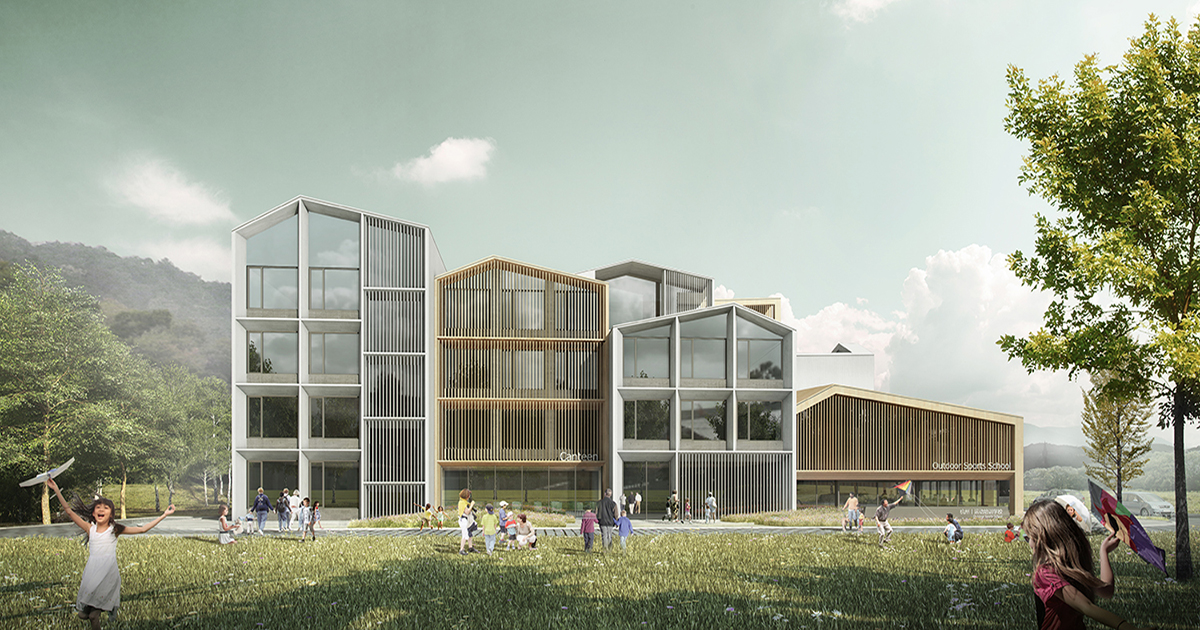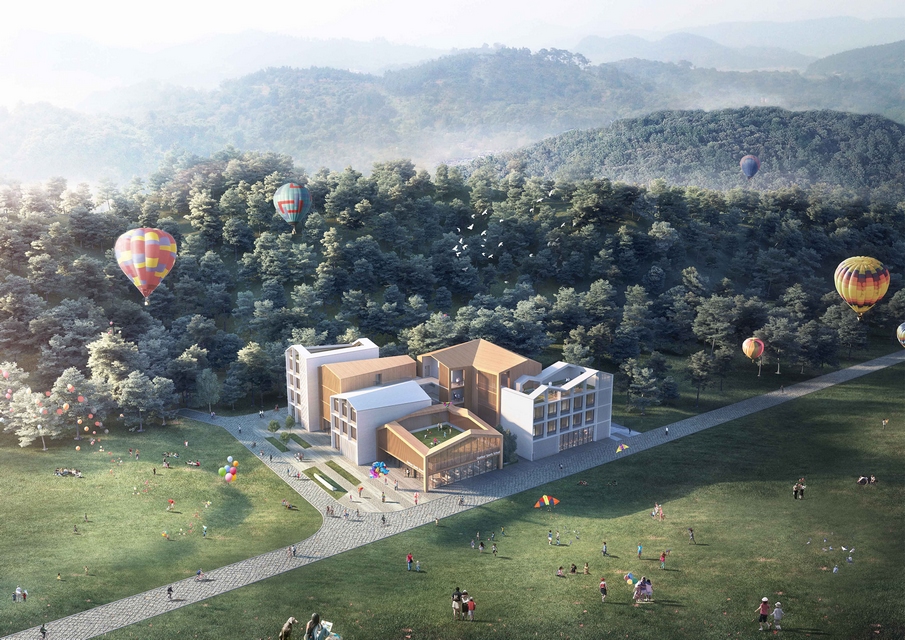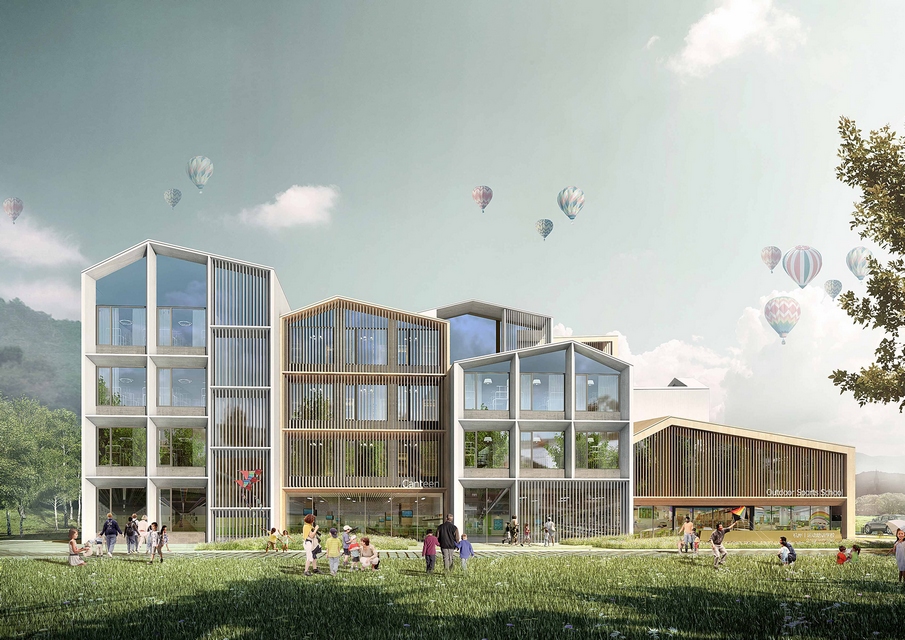Lin’an “Valley of the Wind” School | GWP Architects | World Design Awards 2021
GWP Architects: Winner of World Design Awards 2021. “We hope that the children here can be released into the nature with their dreams as a paper plane into the wind, and experience the fun different than studying in the classroom, as well as the vast amount of knowledge in the outdoor. This was our original intention when we first started designing this school in the nature. We also hope that our design can bestow the love of nature and the spirit of exploration on the students.”
The school is located on an open site among the grassy hills in Lin’an District, outside the City of Hangzhou, with the goal of creating a basecamp of outdoor activities for the young students. The site is in the vicinity of large area of beautiful greenbelts and common open spaces. The north of the site sits on hills, with a local road planned around the south to the west.
The vicinity of the site is mostly undeveloped lands in their original natural forms, but the permitted site area is also extremely limited, at only 2,804 square meters. Therefore, to fulfill all the program and function requirements, the floor area ratio must be close to 2.0, which significantly exceeds the standard 0.8 FAR of typical school building complex and becomes the major challenge in the design of this project.
In order to address this challenge, the design team takes a multi-perspective approach on the project.
First, based off the comprehensive concept of “school in the nature”, the form of this school building architecture should be an existence that can both unify large area of outdoor space in entirety and fully reflect the spirits of youth and outdoor sports. Therefore, we take the paper plane which can carry the dreams and ambitions of the young students as inspiration of the building form, “releasing” the architecture into the air like a paper plane being released by the students. By connecting the visual image with the imagination of the space, the design aims to arouse the young students’ motivations so that they can truly “release their dreams and grow with happiness” while at school.
On top of the inspirational image of “paper plane” , with consideration of specific requirements in function, circulation, regulation, and materials, etc., the design team further interprets the concept into tangible operations of dividing and moving building volumes, making the school both a series of useful physical spaces and a carrier of culture at the same time.
The School in the Nature takes a “summer-camp” model of teaching and learning, with an emphasis on the cultivation of healthy physicality and personality of the students, as well as the ability of exploration and the spirit of mutual aid. This is unique model different from other traditional instructive model of teaching and learning.
To accommodate the new model of teaching and learning as well as the diversity in the students’ development in interest and ability, the corresponding architectural space should also be scenario-based, open, flexible, and dynamic. The dormitory area and the classroom area of the school are in an organic dialogue on each level, creating clear and convenient paths of circulation. Meanwhile, with the focus on architectural space creation, each functional area can be dynamically and efficiently connected.
Rooftops of the building volumes vary naturally in height and are arranged well in order. The folded roofs also interact with the contours of the hills in the background and bring the best image out of each other. The building facades have a rich range of variances, and achieve complementary effects out of contrasts between the white and natural wood colors as well as between the vertical grills and the transparent glasses.
Existing site conditions, paths of circulation, and vigor of the young students have all been thoroughly considered in the landscape design, turning the site into a diverse landscape field that combines sight-seeing, relaxing, communication, and sports altogether. The landscape carries through the features of the rooftops and speak in full concert with the architecture design, enabling the two to merge together smoothly.
In addition, under the circumstance of an extremely tight site, three spacious rooftop gardens have been created on top of the building volumes as stages for group activities. The gardens can also evoke spontaneous activities and diverse events, making them places for dialogues and vehicles of culture.
The School in Nature always emphasizes the prioritized status of students themselves within the school, whether in the model of teaching and learning or in the architecture of the school, making efforts to create architecture of educational significance and hoping all the students can truly “release their dreams and grow with happiness” here after the completion of the school building.
“We invested in the construction of this school with the hope to bring children back to the most natural, pure, simple, and pleasant place deep in their hearts, and they can study and stay in touch with nature here in this dream school with comfort, freedom, and happiness, growing up healthily in the sun.”
Project Details
Firm
GWP Architects
Project Name
Lin’an “Valley of the Wind” School
Architect/Designer
John Zhang
World Design Awards Category
Educational Design concept
Project Location
Hangzhou
Design Time
May 2019 – January 2020
Project Progress
Under Construction,Will be completed in 2021
Land Area
2804㎡
Construction Area
5362㎡
Team
John Zhang,Ping Wang
Country
China
Photography ©Credit
©GWP Architects
 GWP Architects was founded in 2012 in Boston,USA,and began to engage in urban planning and architectural design research. After several years of research, upholding the concept of “establishing a global wisdom alliance”,the core team established HongKong group company and Guangzhou Company, responsible for projects in China and Asia, the works have been highly recognized by the industry and have repeatedly won well-known design awards at home and abroad. The company takes “the balance of creativity and practicality” as the design tenet, and its services cover architectural design, urban planning, landscape design, and interior design.
GWP Architects was founded in 2012 in Boston,USA,and began to engage in urban planning and architectural design research. After several years of research, upholding the concept of “establishing a global wisdom alliance”,the core team established HongKong group company and Guangzhou Company, responsible for projects in China and Asia, the works have been highly recognized by the industry and have repeatedly won well-known design awards at home and abroad. The company takes “the balance of creativity and practicality” as the design tenet, and its services cover architectural design, urban planning, landscape design, and interior design.










